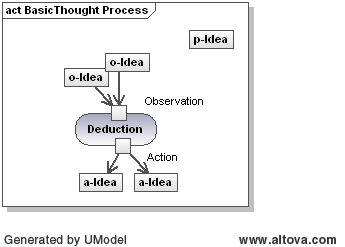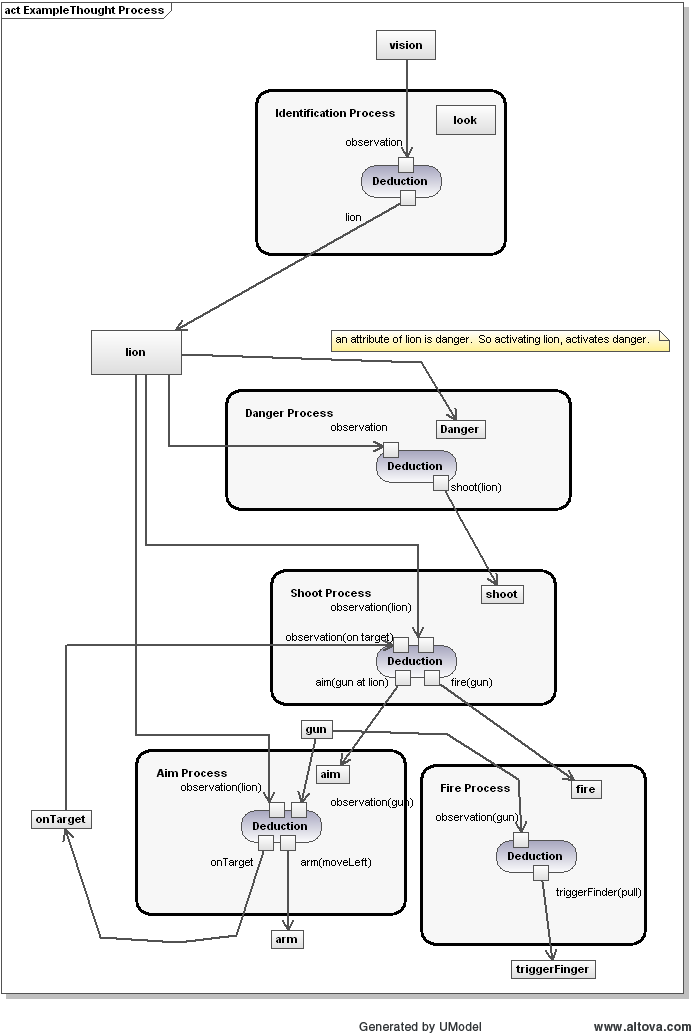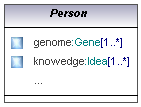Model of the Thought
Outline
This web page describes a model for the thought process which involves:
- Observation: observations from ideas representing external observations or internal thoughts.
- Deduction: deducing from the observations what actions (if any) should be carried out. Deductions are based on knowledge, emotions and reasoning as described on the web page Deduction.
- Action: actions on zero or more ideas, which results in a particular physical or mental action.
Ideas represent each of observations, deductions and actions.
Observations may be at a concrete level coming direct from the senses, or
more abstract ideas of observed shapes deduced from the senses, or even ideas representing classes of physical objects.
For example, the observed idea of an lion associated with the idea of danger (fear)
may be deduced from observation of:
- the lion shape idea activated as a result of deductions against known shapes observed from the visual senses;
- the attacking movement idea activated as a result of deductions against known forms of movement observed from the visual senses;
- the lion roar idea activated as a result of deductions against known sound patterns observed from the auditory senses.
Similarly, actions at a more abstract level may lead through deduction to more concrete actions such as particular movement. For example, the invocation of the idea shoot the lion may lead to the following deductive thought process:
- Until the lion is on target the aim idea is activated, which which in turn causes the thought process of observations of where the lion is and where the gun is pointing leading to the deduction that certain arm movements must be made.
- When the lion is on target the fire gun idea is activated which in turn causes the thought process activates the bend finger physical action.
Observation, Deduction and Action
The activity model for the thought process is described using a variation UML activity diagrams (see
Wikipedia - activity diagram for further information).
Note: This variation of the UML activity relates activities directly to ideas rather than modeling
a straight sequence of linked actions as in the traditional UML activity diagram.
A thought process is modeled as relating to an idea relating to the deductive process (p-Idea), with ideas representing input observations (o-idea) and ideas representing actions invoked as a result of the deductive process (a-idea).
These three elements of the thought process may be described as follows:
- o-Ideas: ideas representing observations input coming from one more ideas ideas associated with a given thought process.
This can include :
- ideas derived directly from the senses (sight, hearing, touch, pain, taste, smell);
- ideas representing abstraction of features deduced from observations such as shape, movement;
- ideas representing an observed object (e.g. lion);
- ideas representing abstract ideas (e.g. hunting);
- ideas representing emotional state (e.g. fear).
- Deduction using the observations to deduce the required action using knowledge, reason and emotion as discussed in Deduction.
- a-ideas: ideas invoked as a result of the deduction. This includes:
- ideas linked directly to motor functions;
- ideas representing an abstract set of coordinated motor functions with a particular aim (e.g. raise arm)
- ideas representing abstract observations deduced from more concrete observations.
- ideas representing emotional state.
- ideas representing knowledge.
[To consider whether p-Idea separate from a-Idea]
The three viewpoints on an idea (o-idea, p-idea, a-idea) described above are not exclusive. The a-idea from one thought process may the o-idea or p-idea for another process. These different viewpoints may be modeled in UML as different interfaces into the same idea:
- "o-"
- observe,
- "a-"
- actOnObject to change its state,
- "p-"
- actOnObject invoking a deductive process.
- An identification process which based on an observation of the visual senses deduces that there is a lion being observed.
- The automatic triggering of the danger process as a known attribute of lions is danger.
- The danger process which deduces that the lion needs to be short.
- The shoot process which firstly activates the aim process until on target then the fire gun process.
- The aim process ...
- The fire process ....
This thought process be represented in UML using an Activity Diagram as shown below:

A set of ideas and deductions may combined together to provide a sophisticated thought process by combining several simpler deductive processes.
Moreover, in the simplest case ideas may individually be active or inactive but by combining associated ideas more complex observations and actions may be achieved.
Deductions may involve a continuous thought process updating the output actions based on the input observations.
An Example
The above model of the thought process may be better understood by considering the process involving observation of a lion leading to the firing of a gun at the lion as illustrated in the following diagram.

The consists of the following processes linked through idea objects which can be associated with a process and also observed.
